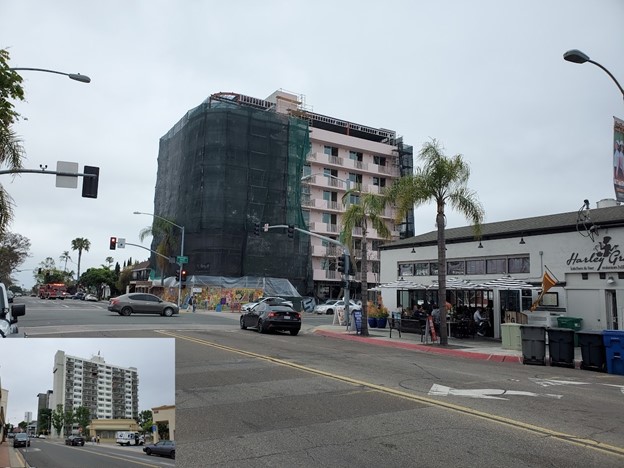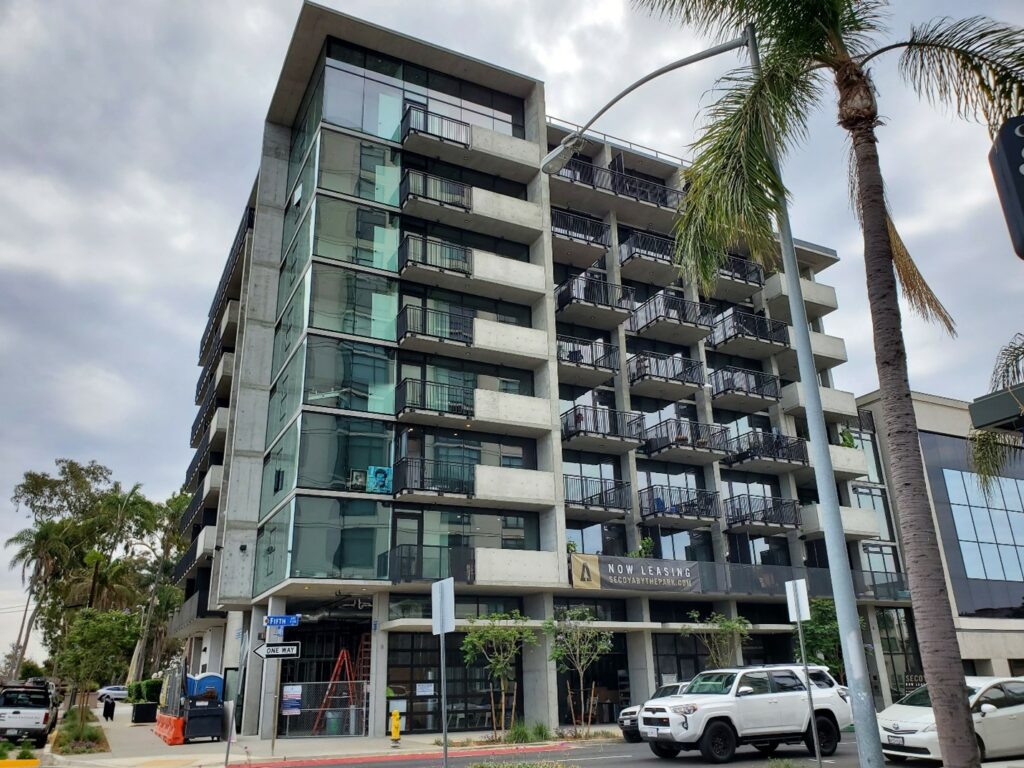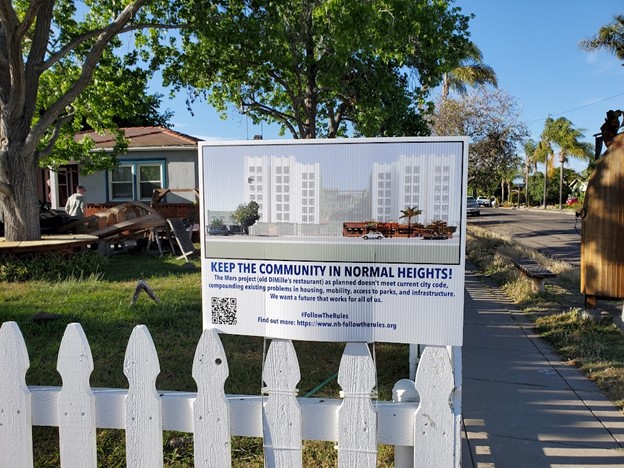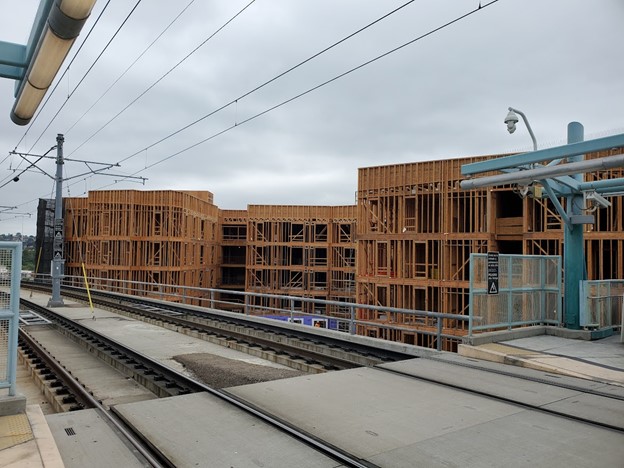By Greg Konar, AICP, May 30, 2023
In December 2019, the City of San Diego adopted Complete Communities Housing Solutions (CCHS), a comprehensive housing ordinance aimed at increasing affordable and market-rate housing in the City’s transit priority areas.1 In short, the ordinance is designed to produce infill housing in precisely the areas that California’s SB 375 legislation, SANDAG’s Sustainable Communities Strategy, and San Diego’s City of Villages General Plan and Climate Action Plan have long targeted. While no single component of the ordinance breaks new ground, the combination of best practices for promoting housing production is remarkable. And it appears to be working.
This article highlights five powerful features of CCHS that have the greatest potential to break down current barriers to infill housing: 1) an “opt-in” parallel zoning code, 2) unlimited density, 3) priority on housing supply, 4) mixed-income on site, and 5) scaled development impact fees. A more complete description of the ordinance, in context with other City of San Diego Complete Community programs, can be found at this webinar video link and on the City of San Diego’s website.

PHOTO CREDIT: Greg Konar, 2023
An “opt-in” parallel zoning code
The centerpiece of CCHS is an “opt-in” provision that makes compliance entirely voluntary. Developers retain the option of building to the existing zoning. No one is forced to opt in; however, when opting in, one can build to a more permissive set of standards. Those standards include preset incentives (in the form of waivers) along with a full complement of requirements that, in concert, significantly relax the requirements of the underlying zoning. The term “parallel” zoning code is used here rather than “overlay” zone because CCHS functions more like an alternative code that applies only when activated by the opt-in.
Opt-in incentives are common in typical affordable housing/density bonus ordinances. What sets CCHS apart, however, is how the incentives are calibrated toward overcoming key barriers to housing production. Among such barriers are insufficient density, excessive value capture requirements, and the uncertainty inherent in discretionary review. If CCHS enjoys sustained success, we could see opt-in/parallel ordinances proliferate as a means to transition to higher densities without resorting to blanket upzoning. Opt-in/parallel ordinances may also prove useful in achieving other land use goals. Given the prevalence and impact of neighborhood politics and NIMBY sentiment, fine-tuning opt-in provisions in a parallel ordinance is likely easier than amending the underlying zoning.
Unlimited density
Of all CCHS incentives, unlimited density is the star attraction. Unlimited density, often associated with form-based codes, has been a valuable urban revitalization tool for decades. While form-based codes remain an excellent regulatory tool, adoption has been slow due to perceived complexity both in crafting and implementation. Many planners are of the opinion that only about 20% of form-based code requirements provide most of the benefits. Verifiable or not, unlimited density would certainly be in that 20%. With form-based codes, public fears of high-rise towers are addressed by a palette of acceptable building types. Each building type is associated with a range of densities, which establishes a practical limit on height and density.
CCHS takes a different approach by simply specifying a maximum floor area ratio (FAR). Unlike a form-based code, permissible building types are not specified. Height is unrestricted as well, making FAR the only regulatory constraint on density. To promote housing production, FARs in transit priority areas have been substantially increased through the adopted City-wide Housing Solutions FAR Overlay Map. The overlay overrides the base zone FAR, but only for those who opt in. Further, the FAR map is partitioned into four descending tiers: Tier 1, no FAR limit; Tier 2, 8.0 FAR; Tier 3, 6.5 FAR; and Tier 4, 4.0 FAR.
With unlimited density and height, the potential for “out of scale” new construction is real. However, the City’s transit priority areas are primarily located along commercial streets and boulevards with some extension into adjacent multi-family areas. Overall, the FAR tiers are based on vehicle miles traveled efficiency, location within a regional or subregional employment area, and proximity to a public university campus. Geographically, Tier 1 is coterminous with the City’s Downtown Community Plan, which already allows unlimited density and has been an effective tool for revitalizing the city’s urban core. Thus, expanding this concept to include the transit priority areas beyond the core is a natural progression. Tiers 2 and 3 apply primarily to the adjacent uptown areas beyond the core and residential areas near University Town Center and UCSD. Precedent for high-rise construction already exists within these areas. Tier 4 applies to San Diego’s Mission Valley and areas to the north. In general, new construction within Tiers 3 and 4 is not expected to exceed seven stories due to major increases in construction costs above seven stories.
Value capture or value priming?
Unlimited density represents a radical departure from the “value capture” approach many cities currently use to encourage affordable housing production. Under a typical density bonus ordinance, increased density is granted in defined increments for providing specified percentages of affordable housing. During the discretionary approval process, additional requirements in the form of community amenities are routinely added as conditions of approval. These additional amenities are largely unforeseen and can easily work against project viability. Not surprisingly, density bonus ordinances have had limited success. In contrast, the up-front granting of unlimited density, as enabled by CCHS, gives developers greater flexibility to design viable projects that can carry the affordable housing load. Developers are free to design projects with large high-end units, smaller affordable units, or any mix in between.

PHOTO CREDIT: Greg Konar, 2023
CCHS does not completely ignore “value capture.” A better term might be “value priming,” where the most attractive developer incentives (unlimited density, lower development impact fees, etc.) are offered in exchange for the most valued community benefits (market rate and affordable housing, infrastructure amenities, etc.). For instance, CCHS requires 40% of the base zone density units to be affordable deed-restricted units, with percentages of each affordability category specified by the ordinance. Required infrastructure amenities include contribution to a neighborhood enhancement fund or (for projects on premises of 25,000 square feet or larger with at least 200 linear feet of street frontage) provision of a public promenade spanning the full length of the longest street frontage. The promenade option, which comes with a list of required features, allows developers to fulfill the infrastructure amenities requirement in a way that benefits the project directly. The key difference from traditional value capture approaches is that all requirements are pre-specified–not just the density bonuses. This allows for ministerial approval providing certainty in the development process. It also saves time and money.
Removal of parking minimums is another development incentive that would be compatible with any jurisdiction’s housing solutions ordinance. This provision wasn’t included in the CCHS because an existing City ordinance already eliminates parking minimums in the transit priority areas. 2 The City’s approach is preferable because it removes parking minimums for all development in the transit priority areas—not just the CCHS opt-in projects.
Priority on housing supply
CCHS embraces the idea that increasing housing supply is fundamental to alleviating the housing crisis. Implicit in this idea is that housing is a social good and a community benefit. In areas with high housing demand and limited supply, building more housing improves housing affordability for everyone. Even the construction of high-end housing eases housing pressures somewhere in the region. Overburdening infill projects with requirements to provide all manner of community amenities is counterproductive when the most acute need is housing itself. As UCLA Associate Professor Michael Manville argues in his provocative essay entitled Value Capture Reconsidered: What if L.A. was Actually Building Too Little?, our collective failure to solve the housing crisis in coastal California is largely a failure to properly value housing as a social good.3
So often, the preservation of community character and protection of property values dominate public discussions about new infill housing. When a housing project is proposed, the typical question posed by neighborhood and community planning leaders is: what’s in it for us? A responsible answer with respect to infill development in transit priority areas is “more economically and socially vibrant commercial districts, greater neighborhood stability, lower crime rates, improved transit viability, and increased political engagement” – all of which enhance community character and maintain property values. When housing is prioritized, the local economy is primed to deliver a variety of neighborhood amenities.
Importantly, CCHS does not dismiss community character or the need for neighborhood amenities. Objective design standards applicable to all opt-in development are included in a section titled Supplemental Development Regulations. These include situational limitations on height and incorporation of transition planes where a project site lies immediately adjacent to a single-family zone. FAR tier boundaries mostly abut multi-family or commercially zoned properties, so these circumstances should be infrequent. As previously mentioned, all opt-in development must meet a neighborhood infrastructure requirement. Additionally, mixed-use developments supported by new residents can be expected to provide commercial neighborhood services and recreational amenities.

PHOTO CREDIT: Greg Konar, 2023
Mixed-income on site
Unlike San Diego’s existing affordable housing ordinance, CCHS encourages the integration of affordable units into the project. It does so by allowing the affordable units to be smaller and more utilitarian than the market-rate units. Equally important, no in-lieu fee options exist. Given the City’s affordable housing history, this represents a stunning turnaround. Incorporating affordable housing into a project has three important benefits. First, it does away with the inherent inefficiencies of in-lieu fees. Construction will occur sooner at much lower per-square-foot costs than if fees were collected, processed, and eventually awarded to an affordable housing developer. Second, it provides potential mitigation for low-income residents displaced by the project’s construction. Third, it virtually assures proper maintenance of the affordable units included in the project. This is especially important for low and very low-income units, which are more vulnerable to maintenance issues when concentrated.
By encouraging affordable units to be built on site, CCHS takes a small but important step toward diversity, equity, and inclusion. Promoting and supporting mixed-income projects and neighborhoods is one of the most important contributions planners can make in this effort. Further, CCHS requires: 1) the replacement of existing affordable units removed by the development, 2) relocation benefits to the occupants of affordable units displaced by the development, and 3) the right of first refusal for a comparable and affordable unit in the new development.
Scaled development impact fees
With the opt-in, development impact fees are restructured (scaled) to incentivize both affordable housing and overall housing production. Fees are based on square footage rather than the number of units. This encourages smaller units likely to be more affordable. Additionally, all development impact fees are waived for covenant-restricted affordable units and units that do not exceed 500 square feet. This also promotes smaller units and removes an obvious barrier to the provision of affordable units. Finally, the neighborhood enhancement fee, previously discussed, is waived for projects that provide 100 percent affordable units. This provides an incentive for non-profit affordable housing developers to build in CCHS areas. As previously mentioned, development under CCHS is “as-of-right,” so there are no unforeseen exactions or conditions as would typically accompany a discretionary review. This saves time, increases processing certainty, and channels resources directly into housing production.
Scaled development impact fees may ultimately prove to be the most important incentive with respect to affordable housing production. Anecdotally, developers have reported project feasibility essentially hinged on this incentive. It follows, then, that any regulatory program aimed at increasing infill housing production in the transit priority areas must pay close attention to development impact fees.

PHOTO CREDIT: Greg Konar, 2023
A way forward
The City of San Diego’s Complete Communities Housing Solutions ordinance is offered here as a potential model for promoting new infill housing in transit priority areas throughout California. It is designed to be implemented at the local level. Individual features could easily be adjusted to meet local circumstances. In the two-plus years that CCHS has been in effect, the ordinance has proven to be especially useful for developers of small lots between 5,000 and 20,000 square feet. This suggests consolidation of smaller lots into larger parcels is not necessarily needed to promote infill housing in the transit priority areas. The economic feasibility of redeveloping smaller lots also has positive implications for preserving the character of existing commercial streets and neighborhoods.
If needed, the State Legislature could pass enabling legislation to assure protection from legal challenges. State support could also come in the form of aligning HCD’s methods of assessing “realistic capacity” within a city’s housing element to embrace the opt-in/parallel code technique fully.4 Additionally, there needs to be clear and meaningful recognition of how new housing affects the affordability of older housing and how older housing contributes to the affordable housing supply.
- In accordance with SB743, “Transit priority area” means “an area within one-half mile of a major transit stop that is existing or planned, if the planned stop is scheduled to be completed within the planning horizon included in a Transportation Improvement Program adopted pursuant to Section 450.216 or 450.322 of Title23 of the Code of Federal Regulations.” ↩︎
- On March 19, 2019, the City Council adopted Ordinance 21057 regarding zero minimum parking regulations for multifamily residential developments in Transit Priority Areas. The parking regulations allow for more multifamily residential units to be built without parking to lower housing costs and encourage residents to use alternative modes of transportation such as walking, biking, and transit. This aligns with the goals of the City’s Climate Action Plan and Housing SD initiative. ↩︎
- Manville, Michael. “Value Capture Reconsidered: What if L.A. was Actually Building Too Little?” UCLA Lewis Center for Regional Policy Studies, June 2021, www.lewis.ucla.edu/research/value-capture-reconsidered/. Accessed 8 October 2023.
From forward: “Should cities only allow new housing on the condition that the developers of that housing deliver public benefits in return? This idea is often called “value capture,” and is used to justify — among other things — various forms of inclusionary zoning. The author argues in this essay that value capture is conceptually and logically flawed. It rests on the idea that new housing is not by itself a public benefit, and on the assumption that not building housing is socially harmless. Most of all, it inverts one of the most important insights in urban economics and urban public finance: that value rests primarily in land, and that development is an important way to share and redistribute land value.” ↩︎ - With “opt-in” ordinances, much of the new housing will be targeted for sites that are already developed. There is no reliable way to predict the order and timing of infill development on individual parcels. Jurisdictions should not be required to waste time and resources on questionable formulaic documentation of realistic capacity. Prior success with opt-in ordinances should suffice, along with a reasonable projection of the number of units likely to be produced city-wide under the ordinance during the housing element planning period. Additionally, given that inadequate housing supply is a major driver of the current statewide housing crisis, it would be reasonable to credit the affordable housing portion of a city’s RHNA allocation with the assumed creation of affordable housing opportunities based on projected market-rate units. The underlying assumption would be that the chain of moves will improve or maintain housing affordability within the metro region’s older housing stock. If underpinned by a rigorous and unbiased study, such a ratio-based credit could prove to be significant. ↩︎
About the Author
Greg Konar, AICP, has over 35 years planning experience including coastal and environmental planning for the California Coastal Commission and the City of San Diego. His private sector consulting work has included specific plans, general plans, housing elements, master plans and entitlement support. Mr. Konar is active in the community through the American Planning Association (APA) and APA San Diego. The views expressed in this article are the author’s own, and publication of this article is not an endorsement of these views by APA Northern Section.
